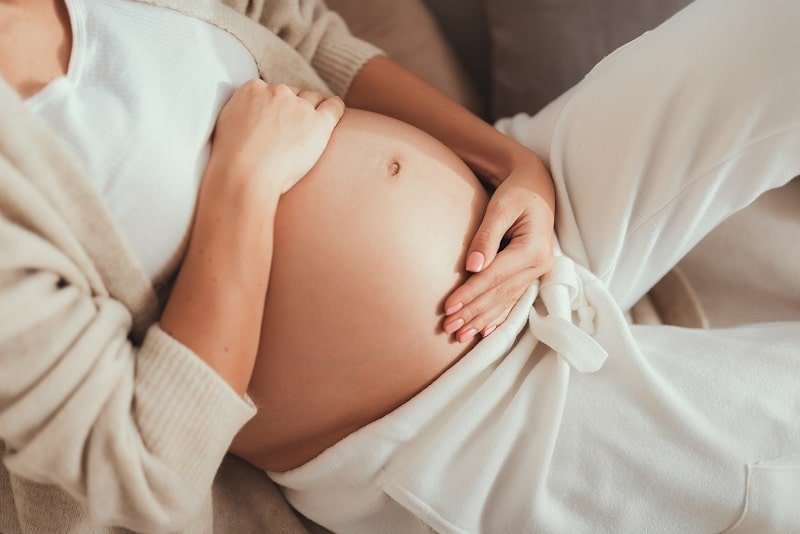Pregnant women have a lot of urinary symptoms during pregnancy, and one of the most bothersome is urinary retention, or the feeling that the bladder does not empty fully. Many women refuse any intervention at this stage, fearing it will harm the baby.
But is this wait-and-see attitude safe for Mum and the baby?

Possible Causes Of Urine Retention In Pregnant Women
In many cases, the reason behind catheterization is not a trivial one. Acute urinary retention (AUR) is rare but can impact maternal and fetal health.
A retroverted uterus is the most common cause of AUR in pregnant women in their second and third trimesters. As the retroverted uterus gets bigger, it presses on the bladder, causing a partial or incomplete blockage.
Other conditions that can coexist and worsen the symptom are myomas, congenital anomalies, uterine prolapse, endometriosis, fibroids, adhesions from past surgery or infection, and low-lying placenta.
Pregnant women can also experience sudden or acute urinary retention anytime during pregnancy because of constipation or urethral obstruction, usually from urinary stones too big to pass spontaneously.
If the pregnant woman can still pass urine and does not look distressed, catheterization can be tried. If seeing a catheter makes you nervous, know those female catheters come in different types and sizes, so the procedure is comfortable.
Indications for Urinary Catheterization

Pregnant women experiencing AUR are monitored closely and treated in the hospital, a urology clinic, or an obstetrics clinic. Correct diagnosis and immediate management can prevent serious adverse effects like the following:
- Acute renal failure
- UTI
- Rupture of the bladder
- Rupture of the uterus
- Colon ischemia or necrosis
- Abortion
- Fetal death
Some pregnant women who cannot stand up, are on bed rest due to cervical or placental problems, or have incurred spinal injury will need long-term catheterization.
Treatment
The first course of action after a thorough assessment and workup is catheterization. In the hands of skilled professionals, it is a fast and painless procedure.
Female catheters are more simple and shorter than male catheters. There are different types depending on how the patient responds.
Depending on the assessment of AUR, the doctor will choose either an intermittent or indwelling type of catheter, a flexible tube inserted through the urethra to the bladder. The distance is estimated to make sure the tube reaches the bladder. In cases like AUR, the catheter is used until the pregnant woman can void completely without assistance.
An intermittent one can be quickly inserted and removed throughout the day. An in-dwelling type stays in place for a longer length of time.
If there are other complications like constipation or impacted stool, this needs to be removed manually or with laxatives.
Safety and Precautions
Catheterization during pregnancy, delivery, and postpartum is never done without a valid reason. In the case of women who are experiencing AUR, insertion of a catheter is a must and nonnegotiable.
Urinary catheterization prevents kidney damage, UTI, and worsening of stones because the bladder is emptied continuously of urine once it is formed. Urine can get concentrated and have a high bacterial count when the bladder is not emptied regularly.
Complications like bladder or uterine rupture, the most feared event, are not likely to occur because the female catheter is short and won’t reach far enough to puncture any organ. It is also very flexible and blunt.
The chance of developing a urinary tract infection (UTI) is minimized by excellent aseptic technique during insertion. However, the chance increases the longer the in-dwelling catheter is in place. Sometimes even with the best technique, UTI can ascend to the bladder and the kidneys.
What To Watch Out For During Catheterization
It’s not enough to see urine coming out when the catheter is inserted. The hospital staff should monitor the condition of the catheter.
Is there a kink from the catheter to the bag? Is the balloon inflated to keep the catheter in place? Is the volume of liquid intake appropriately excreted? And is the urine in the bag clear or cloudy?
Cloudiness may indicate an infection, so the urine must be tested.
The primary reasons catheterization was done in the first place should be addressed because some conditions would require bed rest.
Conclusion
Female catheterization at various stages of pregnancy is safe as long as the catheter is well chosen, inserted using the correct technique, and removed after the emergency has been attended to. Women may also use it to give birth, but this choice should be to your doctor.



